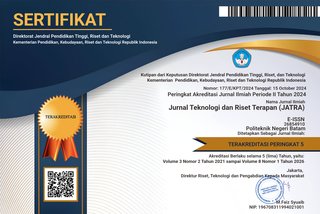Elemental Qualification of Welded Stainless Steels By XRF Positive Material Identification
DOI:
https://doi.org/10.30871/jatra.v4i1.3699Keywords:
Stainless Steel, Elemental Composition, Positive Material Identification, X-Ray FluorescenceAbstract
Tests for determining the elemental composition of stainless steel (SS) in the weld metal and Heat Affected Zone (HAZ) were carried out using the Non-Destructive Evaluation (NDE) Positive Material Identification (PMI) method with X-ray Fluorescence (XRF) technology. This study aimed to identify the chemical composition of metals using the PMI method with XRF technology as a determinant of the feasibility of the stainless-steel materials tested, namely SS 316 and SS 2205. The results of the tests were then matched with the applicable standards, namely ASME Section II Part A for pipe materials and ASME Section II Part C for welding electrodes. The measurement results show that SS 316 with welding electrode grade ER 316 all parts of the object of inspection fall within the standard range used except for material 4, which is the connection between the flange and elbow is declared rejected because the values "‹"‹for Cr, Ni, and Mo do not fall within the standard range. Meanwhile, SS 2205 with a welding electrode grade of ER 2594 shows that all parts of the object being measured meet the requirements of the standard range used.
Downloads
References
K. P. S. Gunasekaran P. Kuppuraj, "Determine the Chemistry of Selected Steel by NDE Technique of Positive Material Identification (PMI)," Int. J. Sci. Res., vol. 3, no. 9, p. "”, 2014.
J. Brocchieri and C. Sabbarese, "Thickness determination of the gilding on brass materials by XRF technique," Nucl. Instruments Methods Phys. Res. Sect. B Beam Interact. with Mater. Atoms, vol. 496, no. March, pp. 29"“36, 2021, doi: 10.1016/j.nimb.2021.03.018.
A. Bolewski, M. Matosz, W. Pohorecki, and J. M. del Hoyo-Meléndez, "Comparison of neutron activation analysis (NAA) and energy dispersive X-ray fluorescence (XRF) spectrometry for the non-destructive analysis of coins minted under the early Piast dynasty," Radiat. Phys. Chem., vol. 171, no. October 2019, p. 108699, 2020, doi: 10.1016/j.radphyschem.2020.108699.
S. Martinuzzi et al., "A robust and cost-effective protocol to fabricate calibration standards for the thickness determination of metal coatings by XRF," Spectrochim. Acta - Part B At. Spectrosc., vol. 182, no. May, p. 106255, 2021, doi: 10.1016/j.sab.2021.106255.
A. Thurston, "Recent Advances in Handheld X-Ray Fluorescence Based Alloy PMI/Material Testing," in 19th World Conference on Non-Destructive Testing, 2016, pp. 1"“8.
ASME, "ASME Boiler and Pressure Vessel Code, Section II Part A - Ferrous Material Specifications," in ASME Boiler and Pressure Vessel Code, 2010, p. 247.
ASME, "ASME Boiler and Pressure Vessel Code, Section II Part C - Specifications for Welding Rods, Electrodes, and Filler Metals,"Specification for titanium and titanium-alloy welding electrodes and rods"," in ASME Boiler and Pressure Vessel Code, 2010, pp. 377"“390.
Analytical Reference Materials International, "Certificate of Analysis Certified Reference Material Grade AISI 321 / UNS S32100," 2009.
Additional Files
Published
How to Cite
Issue
Section
License
Copyright (c) 2022 Jurnal Teknologi dan Riset Terapan (JATRA)

This work is licensed under a Creative Commons Attribution-NonCommercial-ShareAlike 4.0 International License.




11.jpg)











